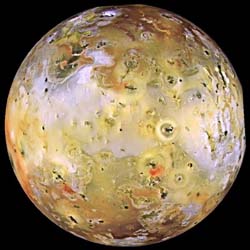Io
Maiden loved by Zeus, who transformed her into a heifer to hide it of the jealousies of Hera.
Looking like a giant pizza covered with melted cheese and splotches of tomato and ripe olives, Io is the most volcanically active body in the solar system. Volcanic plumes rise 300 kilometers (190 miles) above the surface, with material spewing out at nearly half the required escape velocity.
A bit larger than Earth's moon, Io is the third largest of Jupiter's moons, and the fifth one in distance from the planet.
Although Io always points the same side toward Jupiter in its orbit around the giant planet, the large moons Europa and Ganymede perturb Io's orbit into an irregularly elliptical one. Thus, in its widely varying distances from Jupiter, Io is subjected to tremendous tidal forces. These forces cause Io's surface to bulge up and down (or in and out) by as much as 100 meters (330 feet)! Compare these tides on Io's solid surface to the tides on Earth's oceans. On Earth, in the place where tides are highest, the difference between low and high tides is only 18 meters (60 feet), and this is for water, not solid ground!
This tidal pumping generates a tremendous amount of heat within Io, keeping much of its subsurface crust in liquid form, seeking any available escape route to the surface to relieve the pressure. Thus, the surface of Io is constantly renewing itself, filling in any impact craters with molten lava lakes and spreading smooth new floodplains of liquid rock. The composition of this material is not yet entirely clear, but theories suggest that it is largely molten sulfur and its compounds (which would account for the varigated coloring) or silicate rock (which would better account for the apparent temperatures, which may be too hot to be sulfur). Sulfur dioxide is the primary constituent of a thin atmosphere on Io. It has no water to speak of, unlike the other, colder Galilean moons. Data from the Galileo spacecraft indicates that an iron core may form Io's center, thus giving Io its own magnetic field.
Io's orbit, keeping it at more or less a cozy 422,000 kilometers (262,000 miles) from Jupiter, cuts across the planet's powerful magnetic lines of force, thus turning Io into a electric generator. Io can develop 400,000 volts across itself and create an electric current of 3 million amperes. This current takes the path of least resistance along Jupiter's magnetic field lines to the planet's surface, creating lightning in Jupiter's upper atmosphere.
As Jupiter rotates, it takes its magnetic field around with it, sweeping past Io and stripping off about 1,000 kilograms (1 ton) of Io's material every second! This material becomes ionized in the magnetic field and forms a doughnut-shaped cloud of intense radiation referred to as a plasma torus. Some of the ions are pulled into Jupiter's atmosphere along the magnetic lines of force and create auroras in the planet's upper atmosphere. It is the ions escaping from this torus that inflate Jupiter's magnetosphere to over twice the size we would expect.
| Io facts | |
| Discovery: | 01-7-1610 by Galileo |
| Diameter (km): | 3,630 |
| Mass (kg): | 8.94 x 10²² |
| Surface Gravity (Earth = 1): | 0.183 |
| Mean Distance from Jupiter (km): | 421,700 |
| Orbital period (days): | 1.7691 |
| Rotational period (days): | 1.7691 |
| Density (gm/cm³) | 3.57 |
| Orbit Eccentricity: | 0.0041 |
| Orbit Inclination (degrees): | 0.04 |
| Orbit Speed (km/h): | 62,424 |
| Escape velocity (km/sec): | 2.56 |
| Visual Albedo: | 0.61 |
| Typical Subsolar Temperature (K) | 130 |
| Surface Composition: | Sulphur |
Text from David Darling’s encyclopedia.

